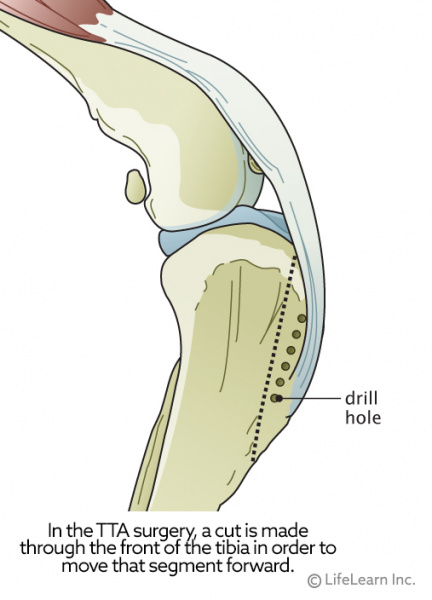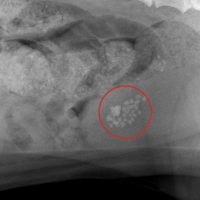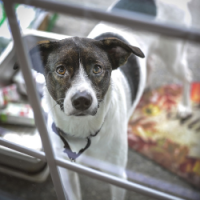One of the most common injuries to the knee of dogs is tearing of the cranial cruciate ligament (CCL). This ligament is similar to the anterior cruciate ligament (ACL) in humans. There are actually two cruciate ligaments inside the knee: the cranial cruciate ligament and caudal cruciate ligament. They are called cruciate because they cross over each other inside the middle of the knee.
When the CCL is torn or injured, the shin bone (tibia) slides forward with respect to the thigh bone (femur), which is known as a positive drawer sign.
Most dogs with this injury cannot walk normally and experience pain. The resulting instability damages the cartilage and surrounding bones and leads to osteoarthritis (OA). It’s also important to note that 50% of dogs who tear a CCL on one hind leg, will tear the CCL on their other hind leg within a year.
What options are there for repairing my dog’s torn CCL?
When the cranial cruciate ligament is torn, surgical stabilization of the knee joint is often required, especially in larger or more active dogs. Surgery is generally recommended as quickly as possible to reduce permanent, irreversible joint damage and relieve pain.
“Surgery is generally recommended as quickly as possible to reduce permanent, irreversible joint damage and relieve pain.”
Several surgical techniques are currently used to correct CCL rupture. Each procedure has unique advantages and potential drawbacks. At Snodgrass Veterinary Medical Center, our veterinarian performs the tibial tuberosity advancement (TTA). We can also schedule a consultation for our veterinarian to decide if the CCL is torn and if surgery is the best route. Click here to schedule an appointment.
What does this surgery involve?
The TTA procedure is more commonly performed in dogs with a steep tibial plateau, or angle of the top part of the tibia.

In simplest terms, the front part of the tibia is cut and separated from the rest of the tibia. A special orthopedic spacer is screwed into the space between the two sections of bone to slide the front part of the lower knee forward and up. This moves the patellar ligament (the thick fibrous band that runs on the front of the knee from the top to the bottom of the joint) into better alignment, thereby removing some of the abnormal sliding movement. A bone plate is then attached to hold the front section of the tibia in the proper position. By changing the alignment of the patellar ligament, the forces that cause the femur to slip backward when the CCL is torn instead move straight down the tibia, resulting in less shearing force or instability.

How long will it take for my dog to recover from TTA surgery?
Healing from TTA surgery is generally rapid.
- About half of all canine patients will begin walking on the injured leg within 24 hours after surgery.
- At 2 weeks postoperatively, most dogs are bearing moderate to complete amounts of weight on the affected leg.
- By 10 weeks, most dogs do not have an appreciable limp or gait abnormality.
- At 4 months postoperatively, the majority of dogs can begin walking and playing normally, with only the most stressful activities restricted.
- Within 6 months, most dogs can resume full physical activity.
Pain management during and after stifle (knee) surgery is critical, so be sure to give all medications as prescribed and use them until they are gone. Physical rehabilitation post-operatively will speed healing. Ask your veterinarian about incorporating rehabilitation into your dog’s recovery plan.
“Pain management during and after stifle (knee) surgery is critical, so be sure to give all medications as prescribed and use them until they are gone.”
The most common complication after TTA is infection. Studies conclude that infection occurs in less than 10% of all patients, with many surgeons reporting much lower complication rates. Your dog will need several recheck examinations and radiographs (X-rays) to ensure that the area is healing properly.

Is TTA better than other types of CCL surgeries?
TTA offers some benefits over older procedures such as extracapsular repairs (ECLS), especially for larger or athletic dogs. Dogs undergoing TTA tend to heal faster, resume normal activities quicker, and have a better range of motion in the knee.
“TTA offers many benefits over older procedures such as extracapsular repairs, especially for larger or athletic dogs.”
Currently, most veterinary surgeons consider TTA to be one of the preferred treatments for larger, more active dogs.
© Copyright 2019 LifeLearn Inc. Used and/or modified with permission under license.






